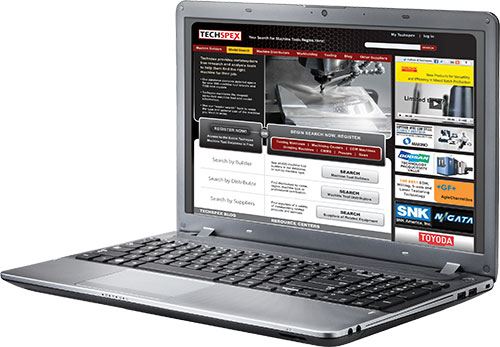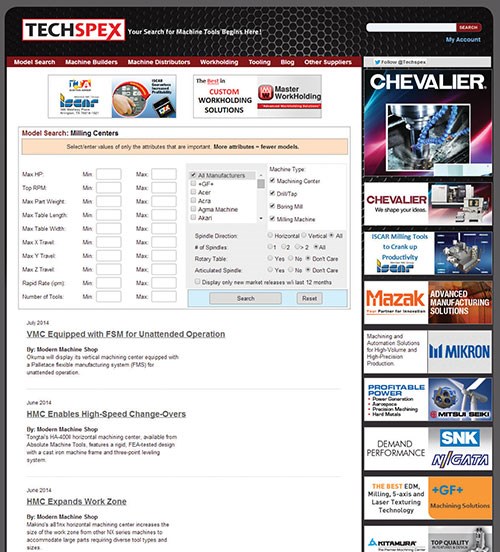Start with the Specs
Techspex has a new website and new capabilities. In place of a word-based search engine, this free utility aims to be the logical starting point for searches aimed specifically at finding the right machine tool.
Share







Takumi USA
Featured Content
View More
Specifications do not say everything about a machine tool. They do not say enough to indicate which machine type is the most efficient choice for a given part. They also say nothing about the company that will sell the machine tool and stand behind it. In short, specs alone cannot tell you which machine to buy.
But specifications say a great deal. They say so much, in fact, that having this information conveniently available can save considerable time in a machine-tool purchasing decision by helping to focus the decision-maker’s attention onto the most qualified options.
That has been the experience of Jim Farral. The staff engineer with the Lord Corporation sought to replace various simple machine tools at the company with multitasking machines capable of consolidating several setups into one cycle. Using Techspex—the online research tool that compares machine-tool specifications—Mr. Farral was able to search for the multitasking machines offering the travels, tool capacity and other characteristics needed for the parts his plant produces. Techspex could not tell him which machine was optimal for his needs, but it told him which machines to consider. That narrowing of the field (while at the same time expanding the field to include some suppliers Mr. Farral otherwise might have missed) improved the quality of his search and saved valuable time.
The Industry’s Assistant
Techspex’s body of data on machine-tool specifications remains comprehensive and current largely because of the ongoing efforts of one man: the site’s creator, Nick Bloom. Specifications get into the machine-tool database because Mr. Bloom routinely scours Modern Machine Shop, machine tool builders’ product announcements and machine tool brochures in search of any machine tool models that aren’t yet in the system. He is essentially the research assistant of every North American machine tool buyer.
Gardner Business Media (publisher of this magazine) began a commercial partnership with Techspex in 2011. Working with Mr. Bloom, Gardner recently launched a new website at techspex.com with new functionality. Users of the site can now make use of features that include:
• The ability to download model data sheets in PDF form to help with sharing search results and referring to them later.
• A “save search” feature that dynamically creates a URL for reproducing any set of search criteria and list of matching models—again for the sake of saving search results and sharing them with others.
• Links from each machine-model data page to distributors representing product lines by region.
• Links to content from Modern Machine Shop and YouTube relevant to individual machines.
• A blog written by Mr. Bloom himself. His granular examination of every new machine tool he learns about makes him a unique observer of the machine tool industry.
• A monthly e-newsletter that includes tips on using the site and deep-dive coverage of individual machine models.
Search on Numbers
Many Techspex users get to the site via Google, he says. Nevertheless, he says a word-based search engine is a limited tool for finding a particular machine—particularly when the details of interest include size, speed, travels or the like. While this point about search engines might seem obvious, people are accustomed to beginning all of their online searches with a general engine, and this is a hard habit to break. Mr. Bloom’s aim with Techspex is to create the most logical starting point for machine-tool-related searches. Don’t try to find a machine tool using words as search terms, he says. Instead, search on numbers that literally delineate the machine you need.
A common way visitors use Techspex is to perform a quick, free search on a set of machine tool parameters as a way of checking whether their own list of vendors for a given machine type is missing any companies that ought to be included. Searches such as this are easy to perform and can be done anonymously, but stopping there achieves only a fraction of what the site can do, Mr. Bloom says. Power users of the site continue their research via machine model pages that combine detailed specifications with photos, descriptions and links to the builder’s other machines, its distributors, and content related to that machine from MMS and other Gardner magazines. Getting to these deeper pages is also free, but requires registration.
Lord Corporation’s Mr. Farral is one of those registered users. Prior to his visit to IMTS 2012, he used the site to develop the list of builders he wanted to be sure to visit during his time at the show. In this way, a short span of time performing thoughtful searches at his desk maximized the value of his time on the show grounds.
But that very exercise of thoughtfulness arguably was also beneficial in its own right. Searching on Techspex forced the engineer to systematically think about the machine function, features and details that truly mattered for his applications. The exercise narrowed his attention to the machines most likely to fit his needs. Without the Techspex search to frame the thinking, this systematic preparation would be an easy step to skip, making the pursuit of a new machine less focused and more time-consuming in the end.
Read Next
Registration Now Open for the Precision Machining Technology Show (PMTS) 2025
The precision machining industry’s premier event returns to Cleveland, OH, April 1-3.
Read MoreBuilding Out a Foundation for Student Machinists
Autodesk and Haas have teamed up to produce an introductory course for students that covers the basics of CAD, CAM and CNC while providing them with a portfolio part.
Read More5 Rules of Thumb for Buying CNC Machine Tools
Use these tips to carefully plan your machine tool purchases and to avoid regretting your decision later.
Read More








































.jpg;maxWidth=300;quality=90)






